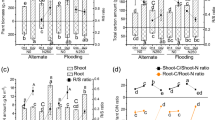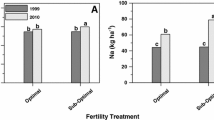Summary
The effects of flooding and lowland rice culture on soil chemical properties and subsequent maize growth were investigated in two contrasting rice soils of S.E. Australia. The effects of incorporating rice straw, either during or after flooding were also studied. The experiment was conducted in a glasshouse with the use of large intact soil cores.
Previous flooding markedly reduced maize growth, leaf P concentration and P uptake, despite the application of a large quantity of P fertilizer after drainage. Soil analyses showed that previous flooding increased the Langmuir sorption terms for maximum P sorption and bonding energy. The availability of P was more closely related to the bonding energy between soil and P than to the capacity of the soils to sorb P. The increases, in the P sorption parameters, were associated with decreases in the crystallinity of the free iron oxides as determined by their oxalate solubility. It was concluded that depressed P supply to maize sown in previously flooded soils was due to stronger P sorption by the drained soils, rather than to P immobilization during flooding.
Rice plants grown during flooding reduced the amount of N available to the subsequent maize crop, but did not significantly affect P availability. Rice straw added during flooding did not affect subsequent maize growth, but when added after flooding caused microbial immobilization of N.
Salts, Fe or Mn from previous flooding did not affect maize growth.
Similar content being viewed by others
References
Bartholomew, R. P. 1931 Changes in the availability of phosphorus in irrigated rice soils. Soil Sci.31, 209–218.
Colwell, J. D. 1959 Phosphate sorption by iron and aluminium oxides. Aust. J. Appl. Sci.10, 95–103.
Fox, R. L., and Kamprath, E. J. 1970 Phosphate isotherms for evaluating the phosphate requirements of soils. Soil Sci. Soc. Am. Proc.34, 902–907.
Gotoh, S. and Patrick, W. H. 1972 Transformations of manganese in a waterlogged soil as affected by redox potential and pH. Soil Sci. Soc. Am. Proc.36, 738–742.
Gotoh, S. and Patrick, W. H. 1974 Transformations of iron in a waterlogged soil as influenced by redox potential and pH. Soil Sci. Soc. Am. Proc.38, 66–71.
Henry, S. 1961 Fixation de l'anion PO4 sur les constituants minéraux des latosols. Bull. Agric. Congo52, 921–929.
Jackson, M. L. 1958 Soil Chemical Analysis. Constable: London.
Johnson, C. M. and Ulrich, A. 1959 Analytical methods for use in plant analysis. Calif. Agric. Exp. Stn. Bull.766.
Jones, J. P. and Benson, J. A. 1975 Phosphate sorption isotherms for fertilizer P needs of sweet corn (Zea mays) grown on a high P fixing soil. Commun. Soil Sci. Plant Anal.6, 465–478.
Landa, E. R. and Gast, R. G. 1974 Mineralogical characterization and adsorptive properties of amorphous and crystalline hydrated ferric oxides. Trans. 10th Int. Cong. Soil Sci.VII, 132–138.
McLeod, S., Stace, H. C. T., Tucker B. M. and Bakker, P. 1974 The simultaneous, measurement of pH, chloride and electrolyte conductivity in soil suspensions. Analyst99, 193–202.
McKeague, J. A. and Day, J. H. 1966 Dithionite-and oxalate-extractable Fe and Al as aids in differentiating various classes of soils. Can. J. Soil Sci.46, 13–22.
Martin, W. E., Sailsberry, R. L., Brandon, M. and Peterson, R. T. 1971. Answering the riddle of poor safflower after rice... banded phosphorus may be the solution. Calif. Agric. Sept. 1971.
Muirhead, W. A., Melhuish, F. M., Higgins, M. L. and Ceresa, A. 1974–75 Rice stubble disorder. CSIRO (Aust.) Division of Irrigation Research, Report. pp 17–20
Northcote, K. H. 1971 A Factual Key for the Recognition of Australian Soils 3rd Ed., (Rellim: Glenside, S.A.).
O'Neill, J. and Webb, R. A. 1970 Simultaneous determination of nitrogen, phosphorus and potassium in plant material by automatic methods. J. Sci. Food Agric.21, 217–219.
Ozanne, P. G. and Shaw, T. C. 1968 Advantages of recently developed phosphate sorption test over the older extraction methods for soil phosphate. Trans. 9th Int. Cong. Soil Sci.II, 273–280.
Paul, H and DeLong, W. A. 1949 Phosphorus studies. I. Effects of flooding on soil phosphorus. Sci. Agri.29, 137–147.
Ponnamperuma, F. N. 1972 The chemistry of submerged soils. Adv. Agron.24, 29–96.
Richards, L. A. (Ed.) 1954 Diagnosis and Improvement of Saline and Alkali Soils. U.S. Dep. Agric. Handb.60.
Schwertmann, U. 1964 Differenzierung der Eisenoxides des Bodens durch Extraktion mit Ammoniumoxalat-lösung. Z. Pflanzenernaehr Dueng. Bodenkd.105, 194–201.
Simpson, J. R. and Williams, C. H. 1970 The effects of fluctuations in soil moisture content on the availability of recently applied phosphate. Aust. J. Soil. Res.8, 209–219.
Singh, B. B. and Jones, J. P. 1976 Phosphorus sorption and desorption characteristics of soil as affected by organic residues. Soil Sci. Soc. Am. J.40, 389–394.
Smith, A. N. 1969 Growth of wheat and changes in phosphorus availability in a waterlogged soil. Agrochimica13, 235–242.
Walkley, A. and Black, I. A. 1934 An examination of the Degtjareff method for determining soil organic matter and a proposed modification of the chromic acid titration method. Soil Sci.37, 29–38.
Willett, I. R. and Higgins, M. L. 1978 Phosphate sorption by reduced and reoxidized rice soils. Aust. J. Soil Res.16, 319–326.
Author information
Authors and Affiliations
Rights and permissions
About this article
Cite this article
Willett, I.R. The effects of flooding for rice culture on soil chemical properties and subsequent maize growth. Plant Soil 52, 373–383 (1979). https://doi.org/10.1007/BF02185580
Received:
Issue Date:
DOI: https://doi.org/10.1007/BF02185580




